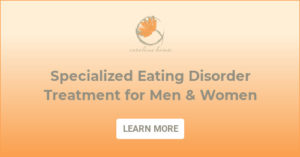- Calls to this hotline are currently being directed to Within Health or Eating Disorder Solutions
- Representatives are standing by 24/7 to help answer your questions
- All calls are confidential and HIPAA compliant
- There is no obligation or cost to call
- Eating Disorder Hope does not receive any commissions or fees dependent upon which provider you select
- Additional treatment providers are located on our directory or samhsa.gov
Hunger & Food Insecurity Can Lead to Binge-Eating Disorder

Contributor: Staff at Carolina House
Of the many eating disorder risk factors, not having enough food probably doesn’t come to mind. But having limited access to food, known as food insecurity, can do significant harm to a person’s overall health and nutrition.
Understanding Food Insecurity
Feed America describes food insecurity as “a lack of consistent access to enough food for every person in a household to live an active, healthy life.” These struggles might be temporary, or they can affect a person or household for many years [1].
There are countless reasons why people across the country are facing hunger. They may have been recently laid off from work, had a work-related accident, or had to choose between paying for car repairs or buying food. And those challenges have been amplified over the last year by the effects of COVID-19.
In 2019, before the pandemic, more than 35 million Americans struggled with food insecurity. That number is projected to increase to 42 million in 2021 because of the economic crisis brought on by the coronavirus [2].
“COVID has just wreaked havoc on so many things: on public health, on economic stability, and obviously on food insecurity,” Luis Guardia, president of the Food, Research, and Action Center, told NPR [3].
Others live in food deserts, where various factors make it difficult to access healthy, affordable food options. In fact, about 19 million Americans live in communities where it is more difficult to get food. This might be because the food where they live is more expensive and lower-quality or because full-service grocery stores are too far to easily get to [3].
Regardless of the cause, a staggering number of Americans are going hungry, and the consequences are devastating.
Call for Help 844-485-6232
Food Insecurity & Binge Eating
When a person is not sure where their next meal is coming from, it can change their relationship with food. They may struggle to stop thinking about food, become highly irritable when they cannot get food, or binge eat once they have access to food [4].
This feast-or-famine cycle causes a person’s food intake to fluctuate based on when food becomes available. Researchers have found that people who are suffering from hunger think about food intensely and struggle to control their eating behaviors when they are around food [4].
Without any support, this cycle of behaviors can develop into an eating disorder. In fact, emerging adults (25.3%) and their parents (11.3%) who are facing food insecurity are more likely to report binge eating than emerging adults (18.4%) and parents (6.4%) who have reliable access to food [4]. And in a survey of 800 college students, those who reported struggling with food insecurity were more likely to meet the criteria for an eating disorder [5].
Binge-eating disorder can be life-threatening without appropriate treatment. People suffering from this condition eat very quickly and past the point of discomfort, and they often feel ashamed or distressed afterward. Most people feel like they have lost control during bingeing episodes, as if they cannot stop eating or control what they eat. And, in some cases, a person may attempt to control their weight after a bingeing episode by purging, which can cause further harm to their body and emotional state [6].
Compared with adolescents who had regular access to food, adolescents living in food-insecure households were more likely to control their weight by using laxatives and diuretics, fasting, eating small amounts of food, or skipping meals. And adult food pantry clients who were struggling with severe food insecurity were more likely than adults who were living with moderate food insecurity to vomit, use laxatives or diuretics, fast, or exercise intensely to control their weight [4].
Dispelling Myths
Unfortunately, myths about eating disorders still exist. These conditions are often viewed as illnesses that only affect people of higher socioeconomic backgrounds because they have the financial means to regularly access food.
But the reality is that eating disorders are complex illnesses that can affect people based on other influences in their lives. For some people, inconsistent access to food can drive uncontrollable urges to binge despite the impact this might have on their body, emotions, or food supply. The shame and guilt they feel afterward may compel them to purge to compensate for the extra food they have consumed, even though others in their household may view this as wasteful.
“Instead of assuming that eating disorders are driven by internally imposed dietary restriction, wanting to lose weight, and internalized weight bias, there might be some external factors,” Janet Lydecker, a psychologist at the Yale School of Medicine, told Stat News. “And if we ignore that, the problem won’t go away even with treatment” [7].
Everyone’s relationship with food and their body is unique. Recognizing hunger and food insecurity as eating disorder risk factors is essential to getting people the treatment they deserve — no matter their background or life circumstances.
References
[1] Feeding America. (2021). What is food insecurity? https://www.feedingamerica.org/hunger-in-america/food-insecurity. [2] Feeding America. (2021, March). The impact of the coronavirus on food insecurity in 2020 & 2021. https://www.feedingamerica.org/sites/default/files/2021-03/National%20Projections%20Brief_3.9.2021_0.pdf. [3] Silva, S. (2020, September 27). Food insecurity in the U.S. by the numbers. NPR. https://www.npr.org/2020/09/27/912486921/food-insecurity-in-the-u-s-by-the-numbers. [4] Hazzard, V. M., Loth, K. A., Hooper, L., & Becker, C. B. (2020). Food insecurity and eating disorders: A review of emerging evidence. Current Psychiatry Reports, 22(12), 74. https://doi.org/10.1007/s11920-020-01200-0. [5] Barry, M., Sonneville, K., & Leung, C. (2021). Students with food insecurity are more likely to screen positive for an eating disorder at a large, public university in the Midwest. Journal of the Academy of Nutrition and Dietetics. https://doi.org/10.1016/j.jand.2021.01.025. [6] National Eating Disorder Association. (2018). Binge eating disorder. https://www.nationaleatingdisorders.org/learn/by-eating-disorder/bed. [7] Arnold, C. (2020, June 25). Among people facing food insecurity, researchers find a hidden health issue: Eating disorders. Stat News. https://www.statnews.com/2020/06/25/eating-disorder-food-insecurity/.About the Sponsor:

The opinions and views of our guest contributors are shared to provide a broad perspective of eating disorders. These are not necessarily the views of Eating Disorder Hope, but an effort to offer a discussion of various issues by different concerned individuals.
We at Eating Disorder Hope understand that eating disorders result from a combination of environmental and genetic factors. If you or a loved one are suffering from an eating disorder, please know that there is hope for you, and seek immediate professional help.
Published on May 5, 2021. Published on EatingDisorderHope.com
Reviewed & Approved on May 5, 2021, by Jacquelyn Ekern, MS, LPC


